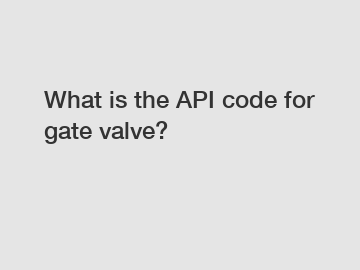What is the API code for gate valve?
Link to apimeivalve
Google Hot Topics: What is the API code for gate valve?
API code for gate valve refers to the specific requirements set by the American Petroleum Institute (API) for the design, manufacturing, and testing of gate valves used in the oil and gas industry. This code ensures that gate valves meet certain standards of quality, reliability, and performance. But what exactly is the API code for gate valve, and why is it important?

1. What is the API code for gate valve?
The API code for gate valve is defined in API 600, which is the standard specification for the design and manufacturing of steel gate valves for the petroleum and natural gas industries. This code outlines the requirements for gate valves in terms of materials, design, dimensions, testing, and marking. It ensures that gate valves meet the necessary standards for use in critical applications such as oil and gas production, refining, and transportation.
2. Why is the API code for gate valve important?
The API code for gate valve is important for several reasons. First and foremost, it ensures the safety and reliability of gate valves used in the oil and gas industry. By setting specific requirements for materials, design, and testing, the API code helps to prevent valve failure and leaks that can lead to costly accidents and environmental damage. In addition, the API code helps to standardize gate valve specifications, making it easier for manufacturers, suppliers, and end-users to ensure that valves meet the necessary standards.
3. What are the key requirements of the API code for gate valve?
Some of the key requirements of the API code for gate valve include:
- Materials: The API code specifies the types of materials that can be used for the body, bonnet, and other components of gate valves. These materials must meet certain standards of strength, corrosion resistance, and compatibility with the process fluids.
- Design: The API code outlines the design requirements for gate valves, including dimensions, pressure ratings, end connections, and operating mechanisms. These requirements ensure that gate valves can withstand the high pressures, temperatures, and flow rates typical in the oil and gas industry.
- Testing: The API code prescribes the testing procedures that gate valves must undergo to ensure their performance and reliability. These tests may include pressure testing, leakage testing, and functional testing under various operating conditions.
- Marking: The API code requires gate valves to be marked with certain information, such as the API monogram, pressure rating, size, and material specifications. This marking helps to identify valves that meet the API code requirements.
4. How can manufacturers and end-users ensure compliance with the API code for gate valve?
Manufacturers of gate valves can ensure compliance with the API code by following the specifications outlined in API 600 and conducting the required tests and inspections. They can also obtain API certification for their products, which demonstrates that their valves meet the API code requirements. End-users, on the other hand, can verify the compliance of gate valves by checking for the API monogram and other markings specified in the code. They can also ask for documentation from the manufacturer to confirm that the valves meet the necessary standards.
In conclusion, the API code for gate valve is a critical specification that helps to ensure the safety, reliability, and performance of gate valves used in the oil and gas industry. By following the requirements of the API code, manufacturers and end-users can be confident that their gate valves meet the necessary standards for use in critical applications.
For more peek seal materialinformation, please contact us. We will provide professional answers.



